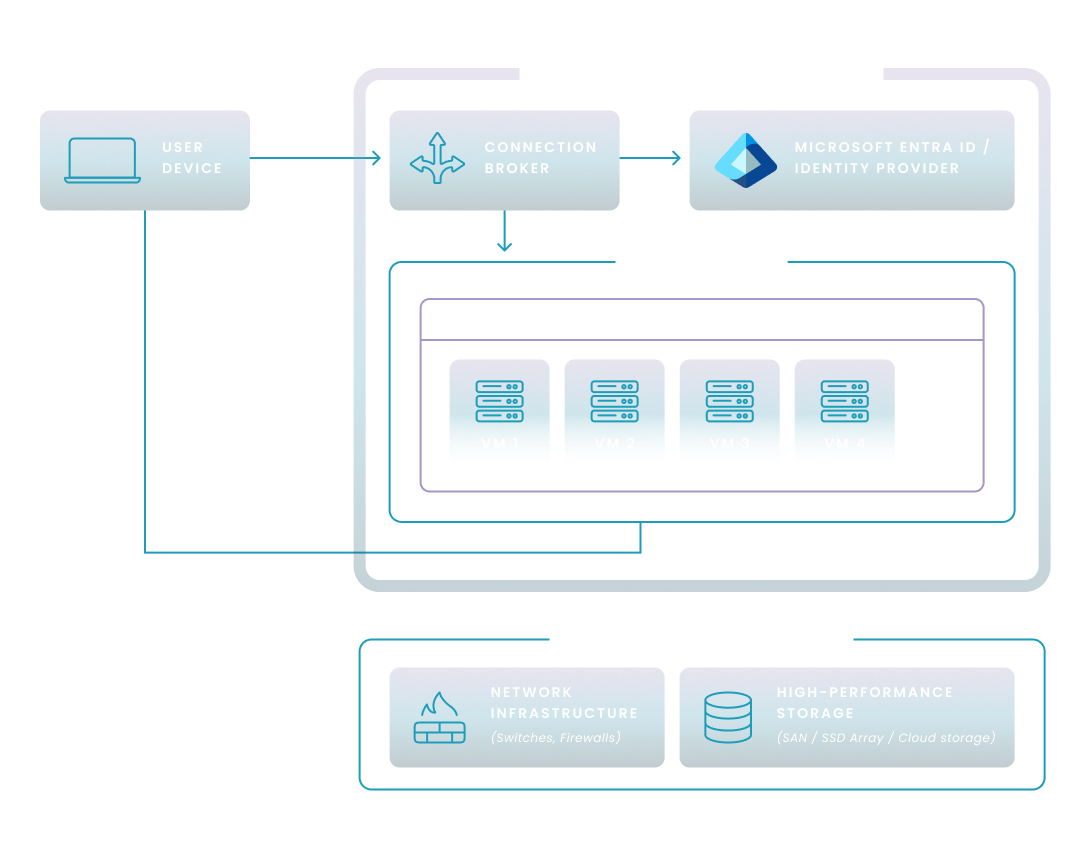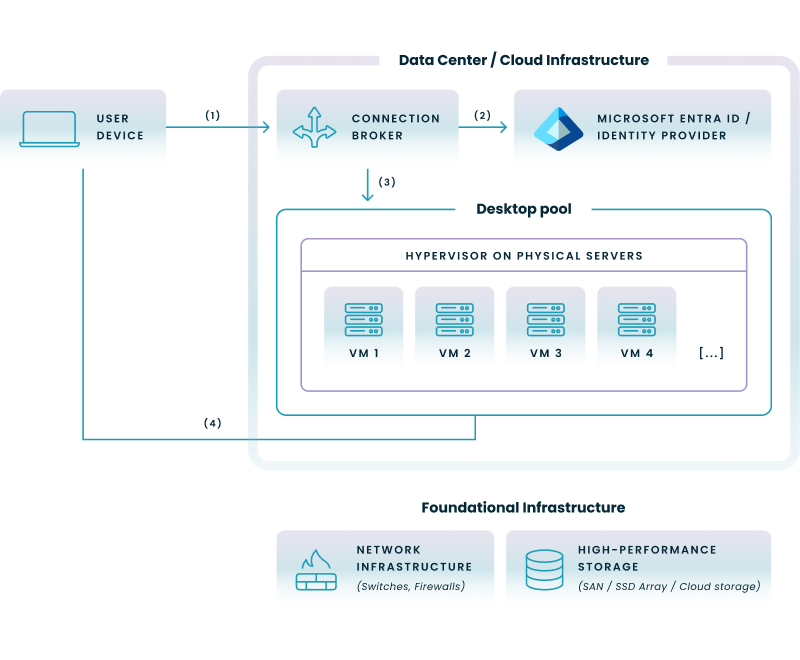VDI Infrastructure
This guide provides an objective overview of VDI infrastructure, covering its components, benefits, challenges, and deployment models.

This guide provides an objective overview of VDI infrastructure, covering its components, benefits, challenges, and deployment models.
Amol Dalvi | June 27, 2025
Virtual Desktop Infrastructure (VDI) is the complete set of technologies required to host and deliver virtual desktops to users. Instead of housing an operating system and applications on each employee's laptop, VDI centralizes them in your data center or the cloud, streaming the desktop experience to users over a network.
This matters because it gives your business a more secure, flexible, and efficient way to manage employee desktops, which is essential for enabling hybrid work, protecting sensitive data, and simplifying IT operations at scale.
At its core, a virtual desktop infrastructure separates the desktop environment from the physical device. This creates a seamless experience for your users while allowing for centralized management by your IT team.
From a user's point of view, the process is straightforward and designed to be intuitive. You simply:
For your IT team, a more complex and powerful process happens in the background:
The user's desktop session is established, and the visual data of the desktop is compressed and streamed over the network to the user's device using a specialized display protocol. User input (keyboard strokes and mouse clicks) is sent back to the server to be processed in real-time. This process provides users with a secure remote desktop experience, giving them access to all their necessary applications and data from a centralized and managed environment.
Understanding the core components is the next step after answering 'what is VDI?', as these technologies are the building blocks of any successful deployment. A successful VDI deployment relies on several core components working together. Understanding each part is key to designing an infrastructure that delivers a great user experience and is easy for your team to manage.

Let’s walk-through the diagram's connection flow:
The hypervisor is the foundational software that makes VDI possible. It's a layer of software (like Microsoft Hyper-V or VMware vSphere) that runs on your physical servers and allows you to create and run multiple virtual machines on a single piece of hardware. This use of a hypervisor is the core of desktop virtualization, a technology that abstracts a user's desktop environment from their physical device, allowing IT to host and manage desktops centrally. This virtualization is what enables the efficient use of your server resources, as you can run dozens of virtual desktops on a server that would traditionally host only one operating system.
The connection broker acts as the air traffic controller for your VDI environment. When a user requests a desktop, the broker's job is to:
Desktop pools are collections of virtual desktops with similar configurations, created from a master image or template. This is where your IT team gains massive efficiency. Instead of managing hundreds of individual physical desktops, you manage a handful of "golden images."
Storage is one of the most critical components for VDI performance and user satisfaction. When hundreds or thousands of users log on at the same time (an event known as a "boot storm"), your storage system must be able to handle an immense number of read/write operations (IOPS) simultaneously. Using high-performance storage, such as Solid-State Drives (SSDs) or a Storage Area Network (SAN), is crucial to avoid bottlenecks that lead to slow, lagging desktops and frustrated users.
Because VDI streams the desktop experience over a network, your network's health directly impacts the end-user experience. A reliable, high-bandwidth, and low-latency network is essential. While VDI display protocols are highly efficient, a poor network connection can still result in screen lag, slow file transfers, and a frustrating experience, especially for remote workers or those using graphics-intensive applications.
VDI is a foundational component of a modern end-user computing (EUC) strategy, which aims to provide employees with secure and consistent access to the applications and data they need to be productive on any device. When properly planned and implemented, VDI can deliver significant strategic advantages for your business. The benefits go far beyond just IT, impacting security, workforce agility, and your bottom line.
While VDI can have a significant upfront investment, it often leads to long-term savings. You can extend the life of endpoint hardware by using lower-cost thin clients instead of expensive, fully-loaded PCs. Furthermore, centralized management reduces operational overhead and can lower costs associated with energy consumption and IT support labor.
VDI is a versatile technology that solves a wide range of business challenges, particularly for enterprises managing diverse and distributed workforces. Its ability to centralize control while providing a flexible user experience makes it ideal for several key scenarios.
This is the most common use case in the modern enterprise. VDI allows your employees to access their full, secure corporate desktop from any location with an internet connection, using a company laptop or a personal device. This ensures a consistent and productive experience for your remote and hybrid teams while keeping all company data secure within your central environment.
Providing secure access to corporate systems for contractors, freelancers, or temporary employees presents a significant security challenge. VDI solves this by streaming a controlled desktop environment to their devices without ever storing company data on them. When the contract ends, access can be revoked instantly, ensuring no lingering data or security risks.
Engineers, designers, and developers often require powerful, expensive workstations with specialized software like CAD or video editing tools. VDI allows you to host these high-performance desktops on powerful central servers and stream them to any user device. This avoids the cost of purchasing and maintaining individual high-end workstations and ensures your intellectual property remains secure in the data center.
In industries with strict data privacy and compliance regulations like HIPAA or PCI, protecting sensitive information is paramount. With VDI, all data is processed and stored in a secure, centralized location rather than on easily lost or stolen endpoint devices. This centralization simplifies security audits and makes it easier to enforce strict access controls, helping to ensure regulatory compliance.
Call centers and environments with shift workers often have multiple employees using the same physical workstations throughout the day. Non-persistent VDI is a perfect fit here, as it provides each employee with a fresh, standardized desktop at the start of their shift. This ensures a consistent user experience and high security, as the desktop is wiped clean and reset after each session.
To build trust and ensure a successful project, it's important to have a clear-eyed view of the potential hurdles. Acknowledging these challenges is the first step to planning for and mitigating them. Carefully evaluating and planning for these factors is critical when selecting from the various VDI solutions available, as the right choice will align with your budget, technical resources, and user experience goals.
An on-premises VDI deployment requires a substantial capital expenditure on servers, high-performance storage, network infrastructure, and software licenses. This upfront cost can be a significant barrier for some organizations, making careful financial planning and ROI calculation essential.
A poorly designed VDI environment can be a productivity killer. If the infrastructure is under-provisioned, users will experience lag and slowness that they wouldn't tolerate on a physical PC. Success requires deep expertise to properly size the environment and constant monitoring to ensure performance remains high.
Software licensing is often more complex in a VDI environment than with physical desktops. You need to navigate specific licensing rules from vendors like Microsoft and others for operating systems and applications running in a virtualized, shared environment. Missteps here can lead to non-compliance and unexpected costs.
Managing a VDI infrastructure requires a specialized skill set. Your IT team needs expertise in virtualization, storage, networking, and the specific VDI platform you choose. This can be a steep learning curve and may require additional training or hiring specialized talent.
You have several strategic options for how you deploy and manage your VDI infrastructure. The right choice for your business depends on your budget, existing resources, and long-term goals.
| Feature | On-Premises VDI | Cloud-Hosted VDI (DaaS) | Hybrid VDI |
|---|---|---|---|
| Cost Model | High upfront capital expense (CapEx) for hardware and licenses. | Predictable operational expense (OpEx) based on subscription/usage. | A mix of CapEx for on-premises components and OpEx for cloud services. |
| Control | Maximum control over all aspects of the infrastructure and data. | Less direct control; you rely on the cloud provider for infrastructure management. | High control over on-premises resources; shared control in the cloud. |
| Management | Your in-house IT team is responsible for all management and maintenance. | The cloud provider manages the backend infrastructure; your IT team manages desktops and users. | Your team manages the on-premises part; responsibility is shared for the cloud part. |
| Scalability | Limited by your physical hardware. Scaling up requires purchasing and deploying new servers. | Highly scalable. You can add or remove users and resources on-demand. | Flexible. You can leverage the cloud for on-demand scalability while maintaining a core on-premises environment. |
In this traditional model, you own, host, and manage all the VDI infrastructure components in your own data center.
With Desktop as a Service (DaaS), a third-party cloud provider like Microsoft Azure or AWS hosts and manages the backend infrastructure for you. Solutions for Azure VDI, such as Microsoft's own Azure Virtual Desktop, are leading examples of the DaaS model, allowing organizations to leverage the global reach and scalability of the Azure cloud for their desktop virtualization needs. For many businesses deeply integrated with the Microsoft ecosystem, these native Azure offerings are considered powerful Citrix alternatives, providing a path to consolidate vendors and simplify licensing.
The result for the end-user is often called a Cloud PC, providing a complete and personalized Windows desktop experience, streamed from the cloud to any device, effectively separating the computing environment from the physical hardware. You manage the desktops and applications, but the underlying hardware and control plane are handled by the provider.
A hybrid model combines on-premises and cloud-hosted VDI. For example, you might keep virtual desktops for power users with specific security needs in your on-premises data center while using DaaS for your broader workforce to leverage its flexibility and scalability. This approach allows you to tailor your VDI strategy to different user groups and business requirements. Historically, a common example of this was running Citrix on Azure, where an organization used Citrix's familiar management tools to deploy and manage virtual desktops hosted on Microsoft's scalable Azure cloud infrastructure.
Join us for a webinar to discover how to take Windows to the cloud. Get insights from industry leaders on navigating the modern workspace and driving secure, cloud-powered operations.
Navigating the complexity of VDI, especially in the cloud with platforms like Azure Virtual Desktop, is where Nerdio adds significant value. We provide a powerful management platform that addresses many of the challenges discussed earlier.
Nerdio provides a single, intuitive management console that sits on top of Azure Virtual Desktop and Windows 365. Instead of navigating the complexities of the Azure portal, your IT team gets a streamlined interface designed specifically for VDI management, automating hundreds of tasks that would otherwise be manual and time-consuming.
Our platform's most powerful feature is its advanced, predictive auto-scaling. Nerdio ensures you only pay for the Azure resources you actually use by automatically scaling your VM hosts up or down to meet user demand. This can reduce your Azure compute and storage costs by up to 75% compared to an unmanaged environment and eliminates the complexity of building and maintaining your own scaling scripts.
With Nerdio, you can simplify image management to ensure desktops are always up-to-date, and integrated monitoring tools help you proactively identify and resolve performance issues. This empowers your IT team to move from being reactive to proactive, ensuring your users stay productive and satisfied with their virtual desktop experience.
See this demo to learn how you can optimize processes, improve security, increase reliability, and save up to 70% on Microsoft Azure costs.
See how you can optimize processes, improve security, increase reliability, and save up to 70% on Microsoft Azure costs.
A prominent example of VDI is Azure Virtual Desktop, which is a cloud-based service from Microsoft that delivers virtualized Windows desktops and applications. Other well-known examples include Citrix Virtual Apps and Desktops and Omnissa Horizon (formerly VMware Horizon). These platforms allow organizations to provide employees with secure access to their work environments from various devices.
The two main types of VDI are persistent and non-persistent. A persistent VDI provides each user with a customizable desktop that saves their settings and changes, much like a physical PC. In contrast, a non-persistent VDI provides a generic, temporary desktop that reverts to its original state after each use, which enhances security and simplifies management.
A virtual machine (VM) is a single virtual computer that runs on a physical server, and it is a core component of VDI. VDI, or Virtual Desktop Infrastructure, is the complete system used to deliver and manage these virtual desktops at scale to users. In short, you use multiple VMs to create a VDI environment for your organization.
Virtual Desktop Infrastructure (VDI) is a technology that hosts desktop operating systems and applications on a centralized server or in the cloud. It separates the desktop environment from the physical endpoint device, allowing users to access their work computer from anywhere. This centralization enhances security, simplifies IT management, and provides greater flexibility for remote work.
VDI works by running desktop operating systems inside virtual machines that are hosted on servers in a data center or the cloud. When a user logs in, a connection broker authenticates them and connects them to their assigned virtual desktop. The user's screen, keyboard, and mouse inputs are transmitted over the network, making it feel like they are using a local computer.
Whether advanced remote access solutions are more cost-efficient than VDI depends on the specific needs of an organization. Cloud-based solutions like DaaS (Desktop as a Service) can have lower upfront costs and a predictable subscription model, which is often more cost-effective for smaller businesses. Traditional on-premises VDI requires a significant initial investment but can offer a better long-term return on investment for larger enterprises with specific security and customization needs.
The different types of virtual desktop infrastructure are primarily defined by their deployment model and how they handle user data. The main deployment models are on-premises VDI, where a company manages its own hardware, and cloud-hosted VDI, also known as Desktop as a Service (DaaS). Within these models, the infrastructure can be set up as persistent, where each user has a dedicated, customizable desktop, or non-persistent, where users get a temporary, generic desktop for each session.



Software product executive and Head of Product at Nerdio, with 15+ years leading engineering teams and 9+ years growing a successful software startup to 20+ employees. A 3x startup founder and angel investor, with deep expertise in Microsoft full stack development, cloud, and SaaS. Patent holder, Certified Scrum Master, and agile product leader.